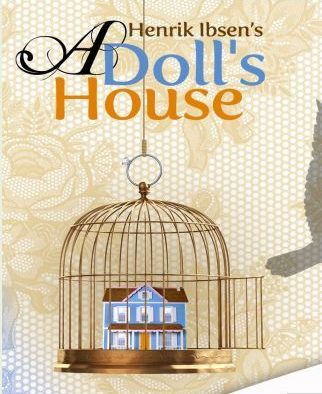Foils in “A Doll’s House”- Learn more here

Short Biography of Ibsen
Henrik Ibsen was a Norwegian playwright. Famously nicknamed the “Father of Modern Drama”, his initial dramas were met with much controversial criticism. William Archer translated many of his social problem plays which granted him fame and acceptance in England. A critic even noticed that Ibsen’s contributions initiated “powerful revival and progress in European Drama”. Some notable masterpieces include Ghosts, The Pillars of Society, A Doll’s House, An Enemy of the People, etc.
A Doll’s House
A Doll’s House is perhaps Ibsen’s most famous play and its significance is made even more portentous as a historian believed that the day the play was published was the day modern drama started. The play presents social and psychological realities behind conventional marriages of that time. Nora, after realizing that she is not appreciated for her sacrifices, leaves her husband and children in pursuit of happiness, identity, and self-discovery. Ibsen’s play was the first modern play to challenge male supremacy. As a critic notes that after Aeschylus, no one dared to challenge the patriarchy until “Ibsen’s Nora slammed the door”.
What are Foils?
Ibsen’s use of foils is one of the many qualities why he is much loved as a dramatist. In A Doll’s House, characters are given much more depth as they are foils to each other. In literature, a foil is typically a character who has a contrasting personality and qualities to another character. The major purpose of a foil is to highlight and differentiate the qualities of the characters so as to understand them better. Christine, or better known as Mrs. Linde, is Nora’s foil while Krogstad is Helmer’s Foil. We will discuss each independently.
Nora and Mrs.Linde
Firstly, Nora and Mrs. Linde are quite opposite. This is evident from their very first meeting. Nora talks about her “good luck” and family. Although she notices that Mrs. Linde is in more terrible circumstances than her, she cannot seem to stop talking about her good fortune, big house and family. This presents Nora as somewhat of an immature child who does not understand when to speak and when to keep quiet. On the other hand, Mrs. Linde mentions her “bad luck” and how she has been working many jobs to keep her family afloat. The readers immediately see a sharp contrast between the two. Mrs. Linde is mature because of her experiences and independence. Nora is a child and certainly living in a “doll-house”, having no worries.
Afterward, when Mrs. Linde mentions that she married for money and her dead husband left nothing behind for her, we see another contrast. Mrs. Linde’s poverty and dire conditions taught her how to be self-dependent and economical. Nora’s life, with all of its privileges and opportunities, spoiled her in a way. Although she was a “spendthrift” in her childhood, this habit continues into her adulthood. She buys luxurious snacks and has no proper sense of debt and borrowing.
Another contrast is seen when Christine mentions she “was privileged to make the end of mother’s life almost free from care.”
At the same time, Nora tells her that her father was ill but Helmer was also gravely sick that she could not tend to her “dying father”. Christine chose to her mother in her hour of need while Nora chose to help her husband. Although they are both caring for someone, there is a slight difference. In a way, Nora abandoned her father because she only went to him for monetary reason and not to take care of him. She took his signature and left with Torvald for Italy.
Another difference is that Mrs. Linde is truthful and honest to everyone in the play. She honestly tells Nora that she married a man she did not love and later confesses her feelings to Krogstad. She does not hide from who she is. However, Nora does the exact opposite. She lies to Torvald for small things like eating macaroons and big instances such as her borrowing scheme. She does not even tell Christine the truth about her secret until she is triggered by her comment of not knowing about the worries of life.
In Mrs. Linde, we see the future of Nora. Mrs. Linde represents the opportunities available to women. They are able to become self-dependent, salaried, responsible and mature. Nora’s future will be similar to Mrs. Linde’s present and vice versa. As the play concludes, Nora is in Mrs. Linde’s place and she is in Nora’s place. Nora is independent without anyone to live for, other than herself. Mrs. Linde, on the other hand, is now happily with a partner and will take care of his children.
Krogstad and Helmer
Two versions of male personalities are depicted in the characters of Krogstad and Helmer. Helmer is Nora’s husband. He is rigid and is a product of society. Helmer is depicted as busy—always working in his office or going to the bank for some official reason. He acts more like a parent for Nora. He scolds her if she strays from his pre-set conditions and ways. Therefore, we assume that he is quite controlling and demanding. This is evidenced by two incidents: when he asks Nora if she’s been eating sweets (as he does not want her to spoil her teeth) and his anger when he finds out that Nora borrowed money.
ALSO READ: MURDER IN THE CATHEDRAL
Helmer also has social respectability and a bright fortune. He has become the manager of the bank and has the support of his family and workers. Meanwhile, Krogstad is not a respectable member of society as his fraud was exposed. He calls Helmer by his first name and terms of endearment which Helmer does not like but says it anyway out of old friendship. Krogstad does not have a bright future and his job is on the line. That is why he threatens to expose Nora’s secret if he loses his job. Therefore, he is a blackmailer while Krogstad has a high sense of morality.
At the beginning, we see Krogstad as Helmer’s dark side. Although both have a liking for social respect and appearances, one is willing to do anything for his and another keeps to his ways. Even when Nora’s secret is out, he keeps up the false pretense instead of threatening Krogstad or anything immoral.
But, at the end, we see how Krogstad is capable of change—something that is not visible in Helmer. He gives up his bad intentions and plans for love while Helmer who already has had the love of his wife for many years is unable to change for her. This is the biggest difference between them. Therefore, Ibsen creates this parallel between characters who switch places at the end to show the different versions of reality that can be adopted by men and women.
Currently, I am a student of Fatima Jinnah Women University. With a burning passion for psychology, words, and dreams, I decided to abandon medical studies for humanities. These days, when I’m not listening to ballads, watching movies, or sitting down with a good novel, I am rigorously studying Hangul (Korean language) to satisfy my obsession for BTS and K dramas. I’m a thinking introvert and INFJ personality. Therefore, I like ‘me time’. My articles typically resonate with psychological well-being advice.









